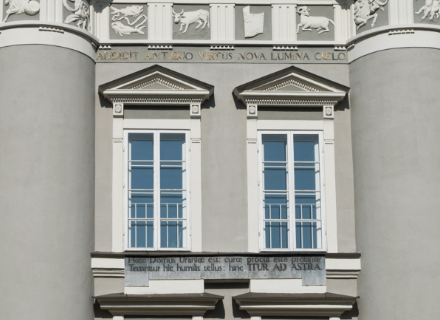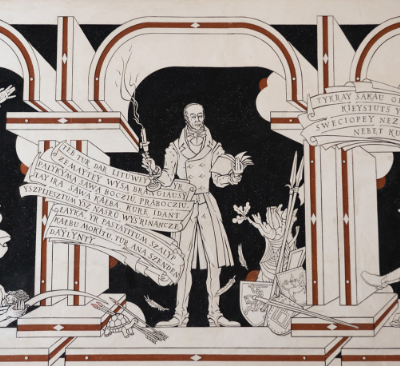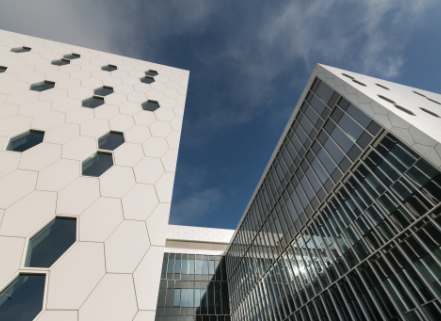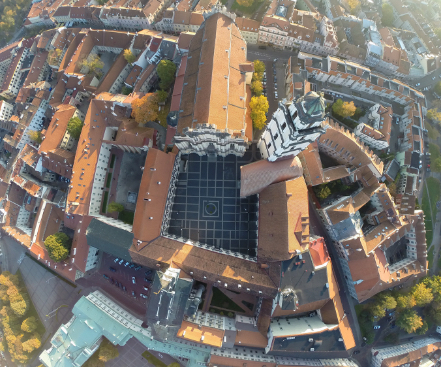History

Hinc itur ad astra
On the Vilnius University observatory wall, there is the quote “Hinc itur ad astra”, which means “from here the way leads to the stars”. The university was founded in the 16th century, with the spread of ideas from the Renaissance, Reformation and Catholic Reformation. Vilnius University is considered to be one of the oldest universities in Central and Eastern Europe. There are other aspects of historical significance at the old university. Since the 14th century, and for two centuries after, the University of Kraków held the title of the easternmost university in Europe, but in the 16th century Vilnius took over this role, transcending the borders of both ethnic Lithuania and the multinational and multi-confessional GDL by shining scientific light on the Central and Eastern European region. Some phenomena of the Jesuit university were so significant they affected the whole of Catholic Baroque and even non-Baroque Europe, including the poetry of Maciej Kazimierz Sarbiewski, as well as the logic, rhetoric and theology of Martinus Smiglecius.
The old Vilnius University era
Vilnius University has gradually moved from the Baroque to the Enlightenment. This process was not substantially hindered even by the annexation of Lithuania to Russia in 1795. According to many contemporaries, the university of the early 19th century was equal to the most advanced universities in Europe. Due to the level of science schools and studies as well as impact on society - the university brought up Simon Daukantas, the pioneer of Lithuanian national revival and well-known poets in Europe, who came from the Grand Duchy of Lithuania, but who became the coryphaeus of Polish modern culture and the prophets of the nation - Adamą Mickiewiczių and Juliuszą Słowackį. All of them witnessed not only the apogee of the university's development, but also the tragedy - in 1832, after suppressing the Polish-Lithuanian uprising, Russia closed the university. Thus, ended the epoch of history, which can be called the old Vilnius University era.

The old Vilnius University era
Vilnius University has gradually moved from the Baroque to the Enlightenment. This process was not substantially hindered even by the annexation of Lithuania to Russia in 1795. According to many contemporaries, the university of the early 19th century was equal to the most advanced universities in Europe. Due to the level of science schools and studies as well as impact on society - the university brought up Simon Daukantas, the pioneer of Lithuanian national revival and well-known poets in Europe, who came from the Grand Duchy of Lithuania, but who became the coryphaeus of Polish modern culture and the prophets of the nation - Adamą Mickiewiczių and Juliuszą Słowackį. All of them witnessed not only the apogee of the university's development, but also the tragedy - in 1832, after suppressing the Polish-Lithuanian uprising, Russia closed the university. Thus, ended the epoch of history, which can be called the old Vilnius University era.

The modern university
A new era in the history of the university began in 1990, as Lithuania regained its independence and the university regained its autonomy. The quote “Hinc itur ad astra” symbolised the academic dreams and the aspirations of former times. In the time of the regained independence, such a symbolic function was probably performed by the modern Centre for Physical Sciences and Technology in Saulėtekis, which is conducting research into laser and light technologies, organic materials, chemistry and semiconductor nanotechnology. The facade walls of this building have no writing on them, but the goals and ambitions of a modern university are symbolised by the hexagonal windows, where an ordinary eye would most likely only see fragments of a honeycomb structure, but an expert eye can see the real symbolism – the crystal lattice of graphene, one of the strongest materials, which was created at the beginning of the 21st century.
From the stars to bacteria
Physical and life sciences are currently an important field of study at the University. The new slogan, a little ironically, could be “from here the way leads to bacteria”. However, the achievements are nowhere near ironic. Recently, the research into bacteria, viruses, molecules and DNA structures have gained worldwide recognition, while the University has announced the discovery of unique, hitherto unknown signalling molecules, and a protein that could be used to precisely edit DNA to alter the genome in specific ways. As a result, Professor Virginijus Šikšnys was among the candidates for the Nobel Prize. The Centre for Physical Sciences and Technology is situated next to the modern Joint Life Sciences Centre, which could certainly compete with its neighbour for the status of a modern university symbol: the complex is designed as cube-shaped structures with exteriors reminiscent of a cellular structure.

From the stars to bacteria
Physical and life sciences are currently an important field of study at the University. The new slogan, a little ironically, could be “from here the way leads to bacteria”. However, the achievements are nowhere near ironic. Recently, the research into bacteria, viruses, molecules and DNA structures have gained worldwide recognition, while the University has announced the discovery of unique, hitherto unknown signalling molecules, and a protein that could be used to precisely edit DNA to alter the genome in specific ways. As a result, Professor Virginijus Šikšnys was among the candidates for the Nobel Prize. The Centre for Physical Sciences and Technology is situated next to the modern Joint Life Sciences Centre, which could certainly compete with its neighbour for the status of a modern university symbol: the complex is designed as cube-shaped structures with exteriors reminiscent of a cellular structure.

University DNR
Since the restoration of independence, the university has constantly had to manoeuvre between the demands of global competition and satisfying the local needs of the state, while at the same time making difficult choices between the roles of a university that satisfies the technocratic market and a classical educator of humanity. The strength of the modern Vilnius University and its aspiration to become the academic home of graphene is measured not only by its historical mission but also by various formal assessments. However, what symbolises today’s Vilnius University the most are the two most important threads of its identity that are twisted like a DNA spiral: its passionate efforts to adapt to the needs and trends of the rapidly changing world; and at the same time, the traditions that have survived since its establishment. The first thread represents the technical and life sciences that have replaced (or were derived from) the logic of the 17th century. The second one represents the poets of the 17th century – even if in (post)modern times, they are often called humanitarians. Thus, while the university enjoys the bonuses of its DNA research, the university’s own DNA has not changed since its establishment.
The most important dates for Vilnius University
-
1569
On the initiative of Vilnius Bishop Valerijonas Protasevičius, Jesuits came to Lithuania and founded the Vilnius Jesuit College in 1570.
-
1579
On 1 April, the King of Poland and the Grand Duke of Lithuania, Stephen Báthory, issue a letter of privilege to open the Vilnius Academy. Then on 30 October, Pope Gregory XIII issued a decree approving the reorganisation of Vilnius College into a university. The official name of the University was Academia et Universitas Vilnensis Societatis Jesu (Jesuit Academy and University of Vilnius).
-
1773
The Society of Jesus was dissolved, the state took over the university and established an educational institution - the Educational Commission.
-
1781
Vilnius University was renamed the Principal School of the Grand Duchy of Lithuania – Schola Princeps Magni Ducatus Lithuaniae. The university, like the whole state, entered an era of reforms, which were interrupted by the last partition of the Polish-Lithuanian state.
-
1795
The Grand Duchy of Lithuania was annexed to the Russian Empire, and Vilnius University was renamed the Vilnius Principal School – Schola Princeps Vilnensis (1797).
-
1803
Russia implemented education and higher education reforms. Vilnius University received a statute to become a model for other universities in the Russian Empire, and was renamed the Imperial University of Vilnius (Vilenskij imperatorskij universitet – Imperatoria Universitas Vilnensis).
-
1832
After suppressing the Polish-Lithuanian uprising, the Russian Empire closed the university.
-
1918
After the First World War, when the Russian Empire collapsed, the governments of the emerging Polish and Lithuanian states put their efforts into restoring the university in Vilnius. On 5 December, the State Council of Lithuania adopted the statute of Vilnius University.
-
1919
The Poles who had occupied Vilnius managed to restore the university. It was renamed after Stephen Báthory (Uniwersytet Stefana Batorego).
-
1922
The University of Lithuania was restored in the temporary capital of Lithuania, Kaunas, and in 1930 it was renamed Vytautas Magnus University (Universitas Vitoldi Magni).
-
1939
Lithuania reclaimed Vilnius and the Polish stage of the university’s development came to an end. The Lithuanian university was moved to Vilnius and was renamed Vilnius University.
-
1940
After the first Soviet occupation, Vilnius University was Sovietised.
-
1941
Vilnius University was re-Lithuanianised, but was already under Nazi occupation until it was closed again in 1943.
-
1944
After the second Soviet occupation, Vilnius University was restored by the Soviet authorities and renamed Vilnius State University.
-
1955
Vilnius University was named after Vincas Kapsukas, a man who had no merit for either the university or Lithuania. At the time of commemorating its 400th anniversary, the university had the longest name in its history – the Vilnius Order of the Red Banner of Labour State University of Vincas Kapsukas.
-
1990
After Lithuania regained its independence, the university regained both its autonomy and the name of Vilnius University.